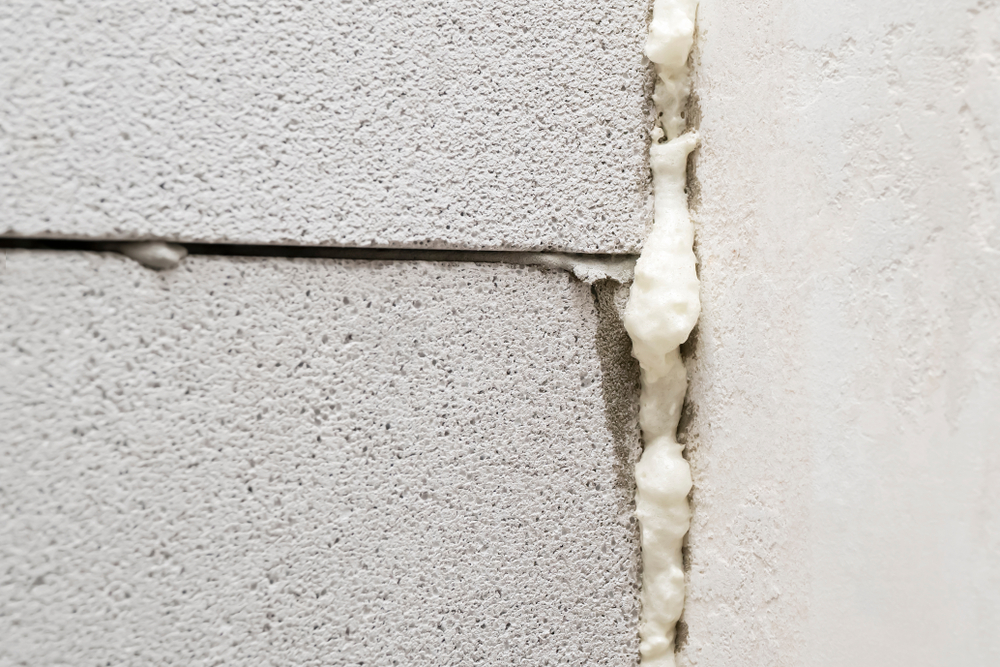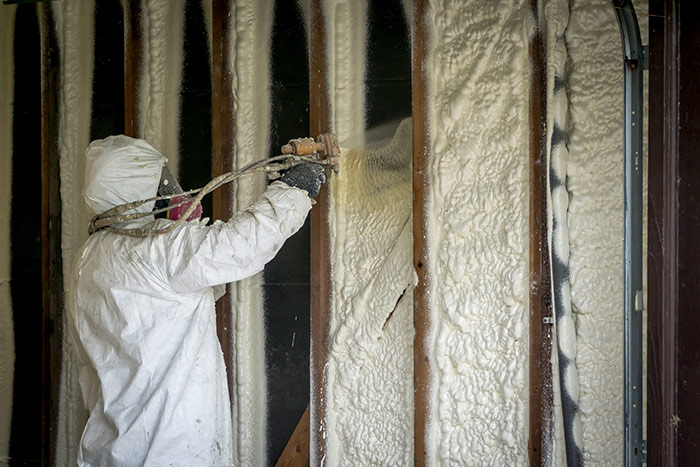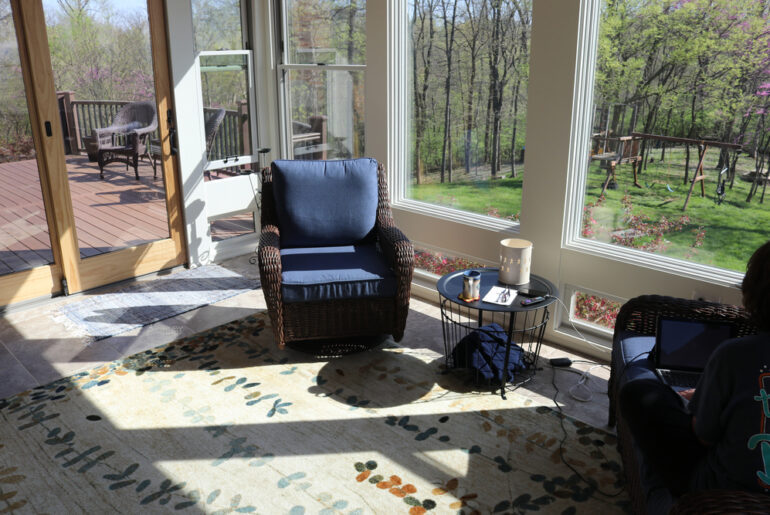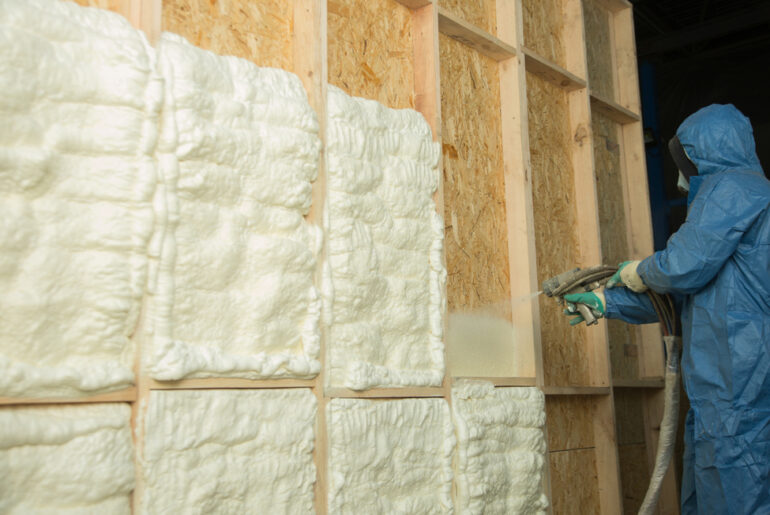Spray foam insulation is incredibly versatile and can be used with many other, more traditional construction materials, to produce the comfort and efficiency levels we expect in our homes today.
Whether your home or business is a new-build project, or you are looking to renovate an existing structure built with concrete blocks, spray foam insulation can be a great choice. The method may differ, but the results speak for themselves.
Injection spray foam is a little different from the insulating material used to spray directly onto a surface, but not unrecognizable, and it has many advantages over other insulation products.
Here’s our guide to using spray foam with your concrete block walls.
Why Use Spray Foam for Concrete Block Walls?
Concrete blocks, or cinder blocks as they are sometimes known, are a fast, lightweight way to build a masonry wall, due in part to the hollow nature of the blocks. However, this honeycomb of spaces within the wall can either be a liability or an opportunity.
Concrete blocks are naturally porous and do nothing for a building’s airtightness, letting in air, and sometimes insects via tiny cracks in the masonry.
Advantages of Using Foam
- Injection spray foam insulation, especially when it has an additive, such as boric acid, can prevent mold, mildew, bacteria growth, and insect attack. It expands to fill every gap, pushing out any opportunity for air to leak out and bugs to get in.
- Filling the cavities within the wall itself also means that there is no loss to internal dimensions, or over-cladding to external walls.
- One of the best advantages of using injection foam insulation is that it can be carried out once all the masonry work is completed, saving build time. Other forms of concrete block wall insulation, such as rigid board are often planned in with the masonry crew, making them vulnerable to weather or accidental damage.
- A foam-insulated masonry wall can reduce heat movement through walls by up to 82%, so whether you have made your home in the desert or the Arctic circle you are going to notice the difference.
- A slower cure allows the foam more time to reach into smaller cracks and crevices, getting into every vulnerable spot inside a masonry wall.
What Spray Foam to Use for Concrete Block Walls?
Injection foam insulation is different from surface spray foam insulation in that it does not expand in the same way. Instead of using a chemical process to fill the space, installation is done by compressed air.
The foam consists of a non-toxic liquid resin which is mixed with a foaming agent, driven by the compressed air to fill every cavity within the block wall.
How to Use Spray Foam to Insulate Concrete Block Walls
- It may be a different process, but injection foam insulation can still get messy, so make sure the working area is properly prepared and that vulnerable surfaces and equipment are properly protected.
- Read through the manufacturer’s instructions so that you are familiar with the foam kit setup, and that everything is put together properly before you begin.
- Check the temperature! If it’s below 40°F (5°C) outside then it could affect the ability of the foam to bond to the masonry.
- Be sure to wear the correct personal protective equipment (PPE) as recommended by the foam manufacturer. Gloves, eye protection and a respiratory mask should be used as a minimum.
- Drill a series of holes in each block, 5/8 or 7/8 of an inch in diameter, approximately four feet up the wall, and a set of corresponding holes at the top. The holes at the top will let you know when the foam has completely filled the vertical cells above your head.
- If the block walls finish inside the attic, under a wall plate, it might be advisable to have a partner on the job who can keep watch and let you know when the foam has reached the top of the wall. Be prepared to drill holes here too before the work commences.
- Start slowly. Let the foam find the bottom of the wall and gradually fill the space.
- As the wall fills up, the next hole along will start releasing foam. This is the signal that it is time to move the injection nozzle to the next location and plug the current hole.
- The foam cools down rapidly and cures within an hour, which means plugs can be removed and mortar finishes applied soon after.
- If you have access to an infra-red camera, then this will tell you whether any areas have been missed due to obstructions or other issues within the wall. To overcome these simply drill a hole and fill.
Alternatives To Spray Foam for Concrete Block Walls
Loose Fill Polystyrene Beads or Mineral Insulation
Polystyrene is an excellent insulator and is a popular choice during construction. It can be poured in at the top of the wall and it needs no specialist training or expertise to carry out the work.
Mineral-based insulators derived from expanded inert volcanic material, filled with tiny air bubbles have excellent fire-resistant properties, but will not upgrade the fire resistance rating of your masonry wall.
However, the biggest problem with loose-fill products such as this is a settlement. Over time gravity will do its work and very often a gap will appear at the top of the wall. Also, loose fill insulators are exactly what they say they are and will not provide a seal.
Applied Foam Boards
Foam board insulation is best when applied to the external wall of a property prior to the installation of wall finishes, such as timber siding. The boards are fixed to the concrete blocks with either a proprietary glue or a mechanical fixing (screw and plug).
The joints between the boards are then sealed with caulk or tape to prevent air or moisture from passing through to the blockwork wall.
If your project is not in a hurry then the time taken to properly fit foam boards could make them a good fit. But you have to make certain that they are indeed a good fit and that the installation team takes the necessary care required.
Fiberglass Batts
Fiberglass or mineral wool batts are another great insulator and can be used to insulate your concrete block walls when fitted internally within a stud frame. Suitable only as part of a planned new construction.
With an existing building it could mean either a reduction in internal living space dimensions or the need to strip out existing drywall, and as such is not recommended when remodeling a home.
Recommended reading: How to Insulate Walls Without Removing Drywall
Blown In Cellulose Fibers
Cellulose, Rockwool, or fiberglass can be blown in-between your drywall, or siding, and masonry wall, but this is not a DIY product. It is installed in a similar way to injection foam, with holes drilled between wall studs and patched afterwards.
Lacking the fluid properties of injection foam, this loose fill product can sometimes snag up on structural cross-members, plumbing or other obstruction within the wall. The settlement of the product is another long-term issue.





